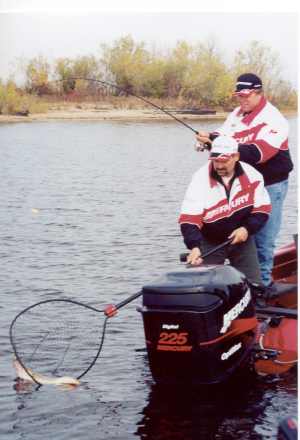 |
|||
|
|
by Norb Wallock Walleyes and weeds, weeds and walleyes. There’s something about that
combination that just doesn’t sound right, or even natural. Walleyes
and rocks on the other hand, makes more sense and sounds a lot better.
Or does it? In many cases weeds and walleyes are a natural, and can make
perfect sense, especially when you consider the options. Finding
walleyes in the weeds is a phenomenon often associated with lakes that
are supported through stocking efforts, and don’t really fit into the classification
of “classic walleye water”. Many of those lakes are more likely to
produce good bass fishing, and lack the natural rock spawning shoals and
reefs needed to support a natural population of walleyes. While the
weeds are probably the first place to look for walleyes
Finding weed walleyes is as easy as finding the weeds, sort of. The problem is the fact that you probably won’t find active walleyes everywhere. Instead, you’ll be more likely to find smaller areas and pockets holding most of the biters. It’s difficult to take a look at a weed bed and know just exactly where the biters will be located, but there are some rules of thumb that can get you started in the right direction. Early in the season, before the weeds have had a chance to get too thick, or too high, walleyes can be found and caught right in the middle of the flat. They nestle down into weeds that are just sprouting up and wait for something tasty to happen by. As the season progresses. and the weeds become much more developed, angers get pushed to the edge, like the deep edge and inside weed line. The deep edge usually holds the key to catching walleyes during the day. By concentrating your efforts on the deepest part of the deep edge, you can increase your chances of finding active fish. A productive method for finding fish on the deep edge, is to slowly troll a live bait rig tipped with a leech, minnow, or crawler. The top all around weed line bait has to be a big lively leech, which can standup to the onslaught of aggressive perch and panfish, and yet still manage to get the attention of hungry ‘eyes. It’s not a fast way to find fish, but there aren’t many short cuts, and it takes a little elbow grease to get the job done. Another option to finding weed line walleyes, is to pull a bottom bouncer and spinner and live bait combination at the base of the weeds, and get going. This method will give you the advantage of some extra speed, and allow you to cover more ground. It might not be the most effective way to put fish in the boat on any given day, but it can at least help you find them. If you pull a fish on a spinner, you might try running the bait through the same area again, or you may decide to switch tactics and slow down with a live bait rig, or cast a jig. If you’ve worked the deep edge thoroughly with little or no success, you may have to go in after them. Depending on weed type and density, you may be able to get by with trolling a live bait rig as far into theweeds as you can. If the weeds are too dense to work a bait through, try looking for holes or pockets inthe weeds. Walleyes will stack up along the edge of a pocket, and are definitely catchable, but require a different approach to be successful. Instead of a rig, or bouncer and spinner, you’re probably better off using a slip bobber technique. A slip bobber can suspend a bait and keep it in front of wandering ‘eyes long enough to get a reaction. Try tying on a small 1/16 oz jig head, tipped with a leech or crawler, and suspended it below a slip bobber, and then cast it into the pockets, giving the bait some time to work it’s stuff. If you’ve given a spot enough time without success, head for the next pocket, and so on, and so on. Another method for picking walleye pockets clean, is to cast a jig head and a plastic trailer, like a Mister Twister Tail, and let it settle down into the weeds, followed by a hard snap that rips the jig through the underwater jungle. That snap will often trigger walleyes that may be turning their noses up at other offerings. Last but not least, is the inside weed line, which can offer the best opportunity for finding walleyes after dark. When the sun goes down, a walleye’s activity level gets turned up a notch or two, and become much more apt to chase down and inhale a bait. Crankbaits cast from extremely shallow water to the inside edge, can be one of the most effective methods for nailing thin water walleyes. The thing to remember is the fact that shallow water walleyes can be extremely spooky, and one wrong move can completely shut things down. You may be better off wading and casting, and leave the boat on the trailer. Norb Wallock
Please visit these site sponsors |
||
|---|---|---|---|
